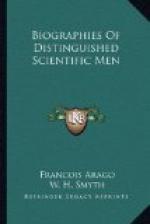Both in the one and in the other of these two telescopes, the small mirror interposed between the object and the great mirror forms relative to the latter a sort of screen which prevents its entire surface from contributing towards forming the image. The small mirror, also, in regard to intensity, gives some trouble.
Let us suppose, in order to clear up our ideas, that the material of which the two mirrors are made, reflects only half of the incident light. In the course of the first reflection, the immense quantity of rays that the aperture of the telescope had received, may be considered as reduced to half. Nor is the diminution less on the small mirror. Now, half of half is a quarter. Therefore the instrument will send to the eye of the observer only a quarter of the incident light that its aperture had received. These two causes of diminished light not existing in a refracting telescope, it would give, under parity of dimensions, four times more[19] light than a Newtonian or Gregorian telescope gives.
Herschel did away with the small mirror in his large telescope. The large mirror is not mathematically centred in the large tube that contains it, but is placed rather obliquely in it. This slight obliquity causes the images to be formed not in the axis of the tube, but very near its circumference, or outer mouth, we may call it. The observer may therefore look at them there direct, merely by means of an eye-piece. A small portion of the astronomer’s head, it is true, then encroaches on the tube; it forms a screen, and interrupts some incident rays. Still, in a large telescope, the loss does not amount to half by a great deal; which it would inevitably do if the small mirror were there.




